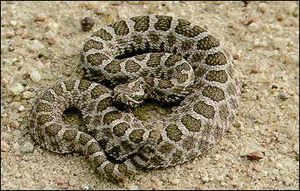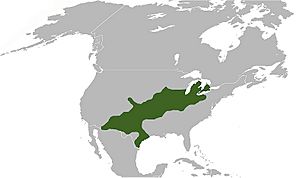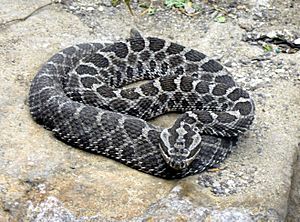Black rattler facts for kids
The massasauga (Sistrurus catenatus) is a type of rattlesnake. You can find it in central North America. This includes southern Ontario, parts of the United States, and northern Mexico. There are three main kinds, or subspecies, of massasauga. Like all rattlesnakes, it's a pit viper. This means it has special heat-sensing pits on its head. All pit vipers are venomous.
Quick facts for kids Massasauga |
|
|---|---|
 |
|
| Conservation status | |
| Scientific classification | |
| Genus: |
Sistrurus
|
| Species: |
catenatus
|
| Subspecies | |
|
3 subspecies, see text |
|
 |
|
Contents
About the Massasauga Snake

Adult massasauga snakes are not very big. They usually grow to be about 60 to 75 centimeters (2 to 2.5 feet) long. Their skin is often grey or tan. They have a row of large, round brown or black spots down their back. There are also three smaller rows of spots along each side.
Some massasaugas are completely black. This is called melanism. Sometimes, the spots on their back can even connect with the spots on their sides. Young massasaugas have clear patterns, but their colors are lighter than the adults. This snake has special heat-sensing pits on its head. These pits help it find warm-blooded prey. Its scales are ridged, and it has a single anal scale.
What Does "Massasauga" Mean?
The word "massasauga" comes from the Ojibwe language. It means "great river-mouth." This name probably describes the grasslands near river deltas in the Ojibwe lands.
People use many different names for this snake. Some common names include massasauga rattlesnake, black massasauga, swamp rattler, and prairie rattlesnake.
Where Do Massasauga Snakes Live?
You can find S. catenatus in North America. Their range stretches from Ontario, Canada, and western New York in the northeast. It goes southwest to southeastern Arizona in the United States and northern Tamaulipas, Mexico.
In Mexico, there are small groups of them in certain areas. These include southern Nuevo León and north-central Coahuila. They also live in Samalayuca, Chihuahua. These snakes live in many different places. You can find them in swamps, marshes, and grasslands. They usually live in areas below 1,500 meters (about 4,900 feet) in height.
Protecting the Massasauga
The massasauga snake is listed as "least concern" by the IUCN. This means it is not currently in great danger worldwide. However, its population trend is not fully known.
Many states in the U.S. consider the eastern massasauga an endangered species. These states include Illinois, Indiana, Iowa, Minnesota, and Missouri. It is also endangered in New York, Ohio, Pennsylvania, and Wisconsin. Michigan lists it as "special concern." This means they are watching its population closely. Since 2016, the massasauga has been listed as "Threatened" under the U.S. Endangered Species Act.
In Ontario, Canada, the massasauga is also listed as "threatened." This is under both the provincial and federal laws. It is protected because its numbers are decreasing. This is due to people harming them and losing their homes.
In Pennsylvania, the snake's numbers have dropped quickly. This is mainly because of habitat loss. People have built on their land, and natural changes in forests have also affected them. By 1988, the snake was gone from half of the areas where it used to live.
What Do Massasauga Snakes Eat?
Massasauga snakes eat many small animals. Their diet includes small mammals, lizards, and other snakes. They also eat invertebrates like centipedes. Mammals and reptiles are a big part of what they eat.
Adult snakes mostly eat rodents. Younger snakes usually hunt reptiles. In western areas, young snakes often eat lizards. In eastern areas, they tend to eat other snakes. Frogs can also be an important food source for them. Some studies show that in certain northern and eastern areas, frogs are a main part of their diet.
Massasauga Venom and Safety
The venom of the massasauga snake is cytotoxic. This means it can damage body tissues. It also has special enzymes that stop blood from clotting. This causes internal bleeding in the small animals the snake eats. The venom helps the snake subdue its prey safely.
Massasauga snakes are usually shy. They try to avoid humans. Most snakebites happen when people try to handle them or accidentally step on them. You can prevent bites by being careful when hiking in areas where these snakes live. Wear shoes and long pants, especially in tall grass. It is always best to leave snakes alone if you see one.
There have only been two recorded deaths from massasauga bites in Ontario. In both cases, the people did not get proper medical help.
Different Kinds of Massasauga Snakes (Subspecies)
There are three recognized subspecies of the massasauga snake. They are found in different parts of North America.
| Subspecies | Taxon author | Common name | Geographic range |
|---|---|---|---|
| Sistrurus catenatus catenatus (S. c. catenatus) | (Rafinesque, 1818) | Eastern massasauga | United States: central and western New York south of Lake Ontario, western Pennsylvania, northern and central Ohio, northern Indiana, lower Michigan, Illinois, southern and southwestern Wisconsin, extreme southeastern Minnesota, eastern Iowa, and northeastern Missouri
Canada: southern Ontario along the shores of Georgian Bay, Lake Huron, and Lake Erie Considered to be its own separate species as of 2011. |
| Sistrurus catenatus edwardsii (S. c. edwardsii) | (Baird & Girard, 1853) | Desert massasauga | United States: extreme southeastern Arizona; central and southern New Mexico; western Texas about as far north and east as the Colorado River; the Rio Grande Valley; and throughout the Texas Gulf Coast region extending as far north as Brazoria County as well as on several barrier islands including North Padre Island, Matagorda Island, and San José Island
Mexico: isolated populations in the country's northeast region bordering Texas |
| Sistrurus catenatus tergeminus (S. c. tergeminus) | (Say, 1823) | Western massasauga | United States: extreme southeastern Nebraska and northwestern Missouri, east-central Kansas, west-central Oklahoma, and northern and central Texas about as far southwest as the Colorado River |
- Ontario Snakes, Ontario Ministry of Natural Resources, Toronto, 1981. Pp. 36.
(Crotalinus catenatus, new species, p. 41).
- Sistrurus at the Reptarium.cz Reptile Database. Accessed 15 September 2007.


